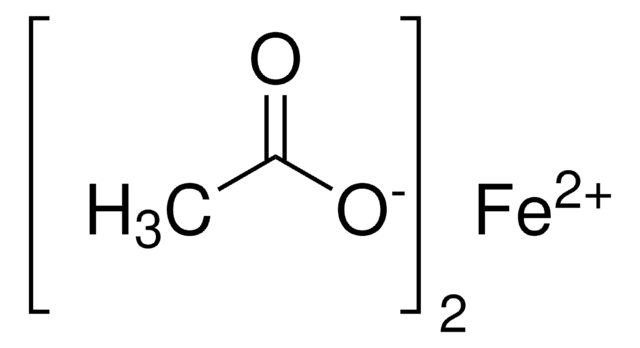413054
Iron
granular, 10-40 mesh, >99.99% trace metals basis
Synonyme(s) :
Ferrum, Iron metal
About This Item
Produits recommandés
Niveau de qualité
Pureté
>99.99% trace metals basis
Forme
granular
Résistivité
9.71 μΩ-cm
Taille des particules
10-40 mesh
Point d'ébullition
2750 °C (lit.)
Pf
1535 °C (lit.)
Densité
7.86 g/mL at 25 °C (lit.)
Chaîne SMILES
[Fe]
InChI
1S/Fe
Clé InChI
XEEYBQQBJWHFJM-UHFFFAOYSA-N
Description générale
Application
- Progress and perspectives on iron-based electrode materials for alkali metal-ion batteries: a critical review.: This review explores the recent advancements and future prospects of iron-based electrode materials in alkali metal-ion batteries, highlighting their potential for high energy density and sustainable energy storage solutions (Li et al., 2024).
- Iron-Based Electrodes Meet Water-Based Preparation, Fluorine-Free Electrolyte and Binder: : This study examines the use of water-based preparation methods and fluorine-free electrolytes in the development of iron-based electrodes, proposing a more sustainable approach to lithium-ion battery production (Valvo et al., 2017).
Mention d'avertissement
Warning
Mentions de danger
Conseils de prudence
Classification des risques
Flam. Sol. 2 - Self-heat. 2
Code de la classe de stockage
4.2 - Pyrophoric and self-heating hazardous materials
Classe de danger pour l'eau (WGK)
nwg
Point d'éclair (°F)
69.8 °F
Point d'éclair (°C)
21 °C
Faites votre choix parmi les versions les plus récentes :
Déjà en possession de ce produit ?
Retrouvez la documentation relative aux produits que vous avez récemment achetés dans la Bibliothèque de documents.
Articles
In recent years, the price of tellurium, a key component in the bestperforming thermoelectric materials, has increased significantly, leading to the question, “Is it economically viable to produce thermoelectric generators on an industrial scale?
The price of tellurium, a key component in many thermoelectric materials, has risen in recent years, leading to the search for more cost-effective substitutes. This article presents silicide materials as a cheaper potential alternative.
The unique properties of the rare-earth elements and their alloys have brought them from relative obscurity to high profile use in common hightech applications.
Notre équipe de scientifiques dispose d'une expérience dans tous les secteurs de la recherche, notamment en sciences de la vie, science des matériaux, synthèse chimique, chromatographie, analyse et dans de nombreux autres domaines..
Contacter notre Service technique




